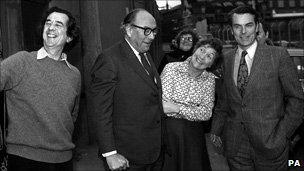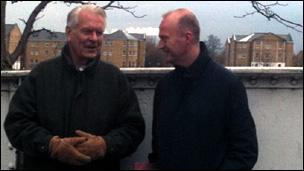The legacy of the SDP's Gang of Four
- Published

The "Gang of Four" in Limehouse in 1981
There's no equivalent of the blue plaque for heroic failures.
If there was, the small iron canal bridge next to the Thames at Limehouse in east London might qualify for a memorial.
On 25 January 1981 four politicians - three of them Labour MPs, the fourth the former deputy leader of the party and all of them ex-cabinet ministers - posed for photographs on the bridge.
The Limehouse Declaration was the first public move towards creating the Social Democratic Party.
The SDP existed for less than a decade, but its influence is still felt today.
The immediate cause was Labour's decision to give party members and the unions a say in electing the party's leader. The left no longer trusted MPs to do it.
One member, one vote
The gang of four, as they became known, believed that unless this electoral college guaranteed one member, one vote, the real decision would be handed to union officials and far left activists who had taken over local parties.
David Owen still lives in Limehouse, in the house where the gang of four met.
The electoral college, he says, is the stumbling block preventing him from returning to the Labour Party.
Although "one member, one vote" is now the rule, you do not actually need to belong to the party to vote, and some people have multiple votes.

Shaun Ley joined Lord Owen in Limehouse, where he still lives
Today, it seems odd to get hung-up about non-party members having a say.
The fashion is for "primaries", used by the Conservatives to choose some of their MPs, in which local people took part, whether they were Tory members or not.
But Lord Owen points to the embarrassment caused to Ed Miliband, who won the Labour leadership because he had a commanding lead among the union members, even though his brother was the first choice of MPs and Labour's rank and file.
Lord Owen speaks warmly of Miliband, and told me "my heart belongs to Labour".
By-election wipeout
He would like to see a Labour government elected in 2015, or a coalition between it and the Liberal Democrats, the party which the other members of the gang of four helped to create, after much of the SDP merged with the Liberals in 1988.
Lord Owen resisted merger, but in one way, they were right and he was wrong.
The Liberal Democrats grew into a formidable political force, the SDP withered, finally extinguished after a humiliating seventh place finish in a by-election in 1990, behind the Monster Raving Loony Party.
The SDP legacy can be found in the coalition. Liberal Democrats such as Vince Cable and Chris Huhne are former members, as are the Health Secretary Andrew Lansley and Greg Clark, the local government minister, both of whom are Conservatives.
But more important for Lord Owen is that politics today is less tribal than it was in 1981.
He credits the SDP. Others dispute that; but unquestionably the political horizon looks different standing on the Limehouse Bridge now than it did 30 years ago.
- Published28 September 2010
- Published25 September 2010